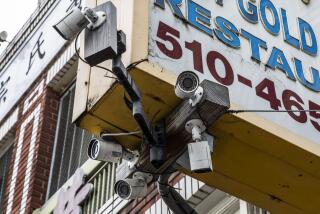How San Diego County is dealing with the ‘tsunami of data’ from police body-worn cameras
It starts with a double-tap of a button.
A relatively small, squarish device mounted on a police officer’s chest begins to record sound, capturing contact with people in the field. An officer could have a dozen or more such interactions in a single shift, resulting in hours of video.
If there’s an arrest, and the potential for charges to be filed in court, prosecutors have to review all of that footage.
The San Diego County district attorney’s office, which handles all felonies and most misdemeanor cases in the region, expects to receive more than 100,000 videos from police body-worn cameras this year.
NEWSLETTER: Get the day’s top headlines from Times Editor Davan Maharaj >>
Deputy Dist. Atty. Damon Mosler said the office received more than 40,000 videos in eight to nine months in 2015. He and others have spent nearly two years trying to figure out the most efficient ways to collect, categorize, review and store the video. It’s an expensive and time-consuming process that’s becoming even more complicated as more departments adopt the technology.
“It is a national conversation,” Mosler said. “We are ahead of the curve, but we are still not where we have to be or are going to be.”
Among the questions being addressed: Who within each office will review the videos? How long will the data be stored? How, considering issues of safety and privacy, will it be turned over to the defense?
“We have to try to view the most relevant videos first,” said Mosler, explaining that prosecutors can’t go over all videos from every case submitted before deciding whether to charge a person with a crime. “When you have 20 minutes to make a decision, you can’t look at four hours of video.”
Randy Mize, a chief deputy public defender, acknowledged that the volume of the information is daunting, but he said increased availability of body-camera video could have positive effects for defendants, criminal lawyers and police.
“There’s nothing like seeing it as it went down,” he said.
So far, prosecutors have been sharing some videos digitally with defense attorneys. Others have been made available for viewing in the district attorney or city attorney’s offices.
In San Diego County, four police departments have issued body-worn cameras to patrol officers: San Diego, Chula Vista, Coronado and Escondido. Some other agencies are using them as well, including Southwestern College in Chula Vista and the San Diego Metropolitan Transit System.
Mosler said there are close to 1,000 body-worn cameras now in use by law enforcement around the county, and many more departments — including Oceanside, Carlsbad, El Cajon, La Mesa, National City and the county Sheriff’s Department — are considering adopting a program in the near future.
That would probably add 1,800 cameras or more to the mix, Mosler said.
Body-worn cameras have been praised for helping to reduce the number of complaints against law enforcement officers, and some jurisdictions have reported a reduction in the number of incidents involving police use of force.
But prosecutors say the cameras aren’t always helpful in determining what happened during an incident. Instead, they show the aftermath — what the witnesses reported and how the officers responded.
“Most police work is reactive,” Mosler said. “You’re not going to catch the act on tape.”
See more of our top stories on Facebook >>
Escondido was one of the first police departments in the county to equip officers with body-worn cameras. Chief Craig Carter said they are required to activate the devices, which cost $400 apiece, during every contact with the public. That adds up to thousands of hours of video that prosecutors could use as evidence in a case, or to help them make decisions about whether to file charges at all.
“It’s one of the most dynamic pieces of equipment, [with] policies that change so frequently, that I’ve ever seen in my career,” said Carter, who also leads the San Diego County Police Chiefs and Sheriffs Assn.
Escondido Police Sgt. Craig Miller said that the department’s Taser-brand cameras are always recording passively and without sound so that they can capture images from 30 seconds before an officer presses a button on the device to activate it.
“Some camera systems don’t have that pre-event buffer,” Miller said.
The cameras can record for hours. At the police station, they are placed into a dock that uploads the video to storage. Officers can view videos recorded on their own devices if they need to prepare a report or get ready to testify at a court hearing.
The system does not allow the officers to delete video. If a prosecutor redacts information later — to remove a witness’ identifying information, for example — the change is noted on the video and in a computer log.
City and state laws determine when videos can be purged and under whose authority. Some jurisdictions require city council approval before destroying certain kinds of digital data.
For now, Mosler said, his office is assessing how much time it takes to go through the data as prosecutors receive it, and what effect it will have on the workload.
“We’re trying to lessen the adverse consequences of the tsunami of data,” he said.
dana.littlefield@sduniontribune.com
Littlefield writes for the San Diego Union-Tribune.
ALSO
O.C. escapees held a prisoner while on the run -- and fought over whether to kill him
35 former members of California Coastal Commission oppose effort to oust executive director
Port of L.A. terminal fails to comply with pollution-reduction mandates, officials say
More to Read
Start your day right
Sign up for Essential California for news, features and recommendations from the L.A. Times and beyond in your inbox six days a week.
You may occasionally receive promotional content from the Los Angeles Times.






